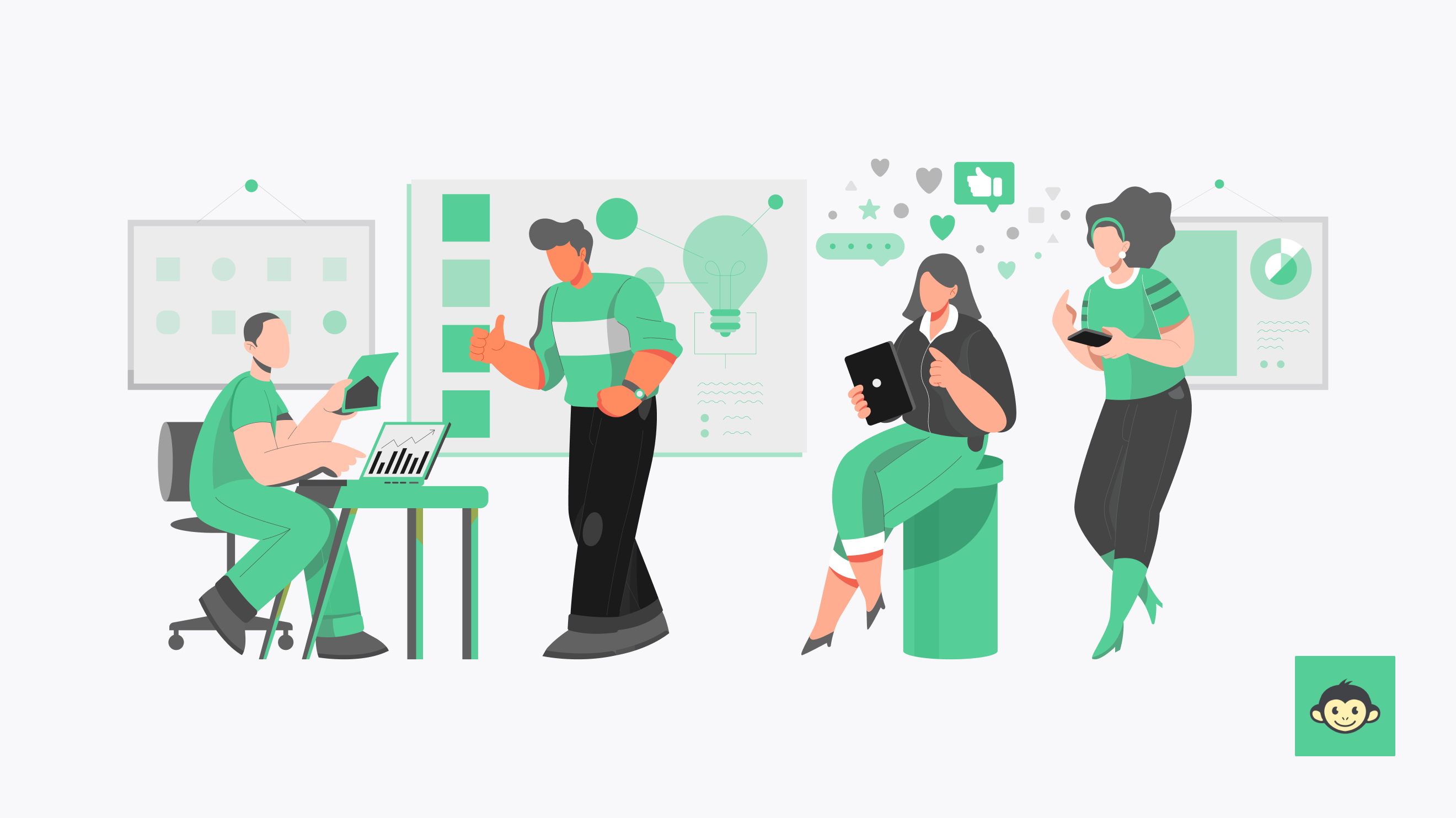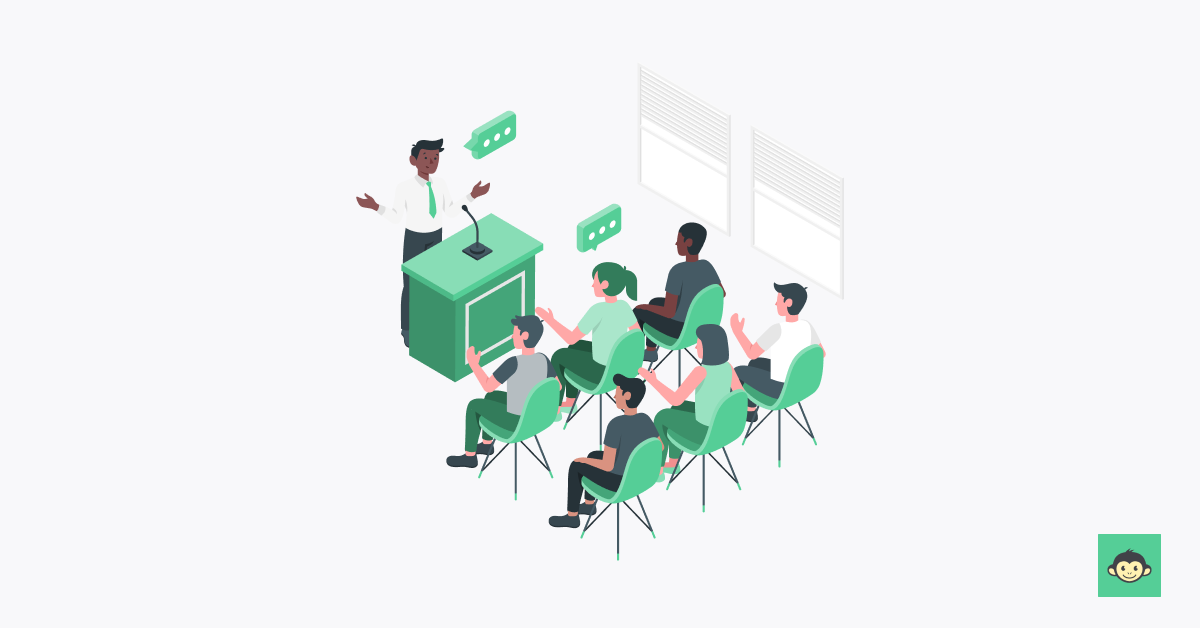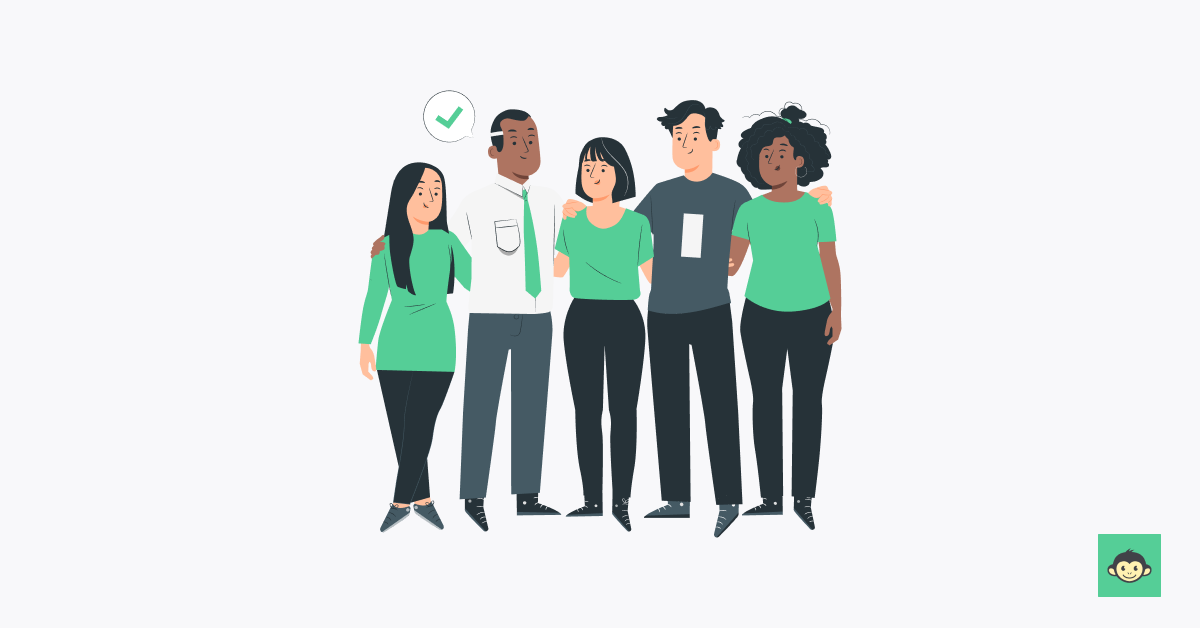What is DEI awareness: Examples and top strategies to improve DEI at work

Diversity, Equity, and Inclusion abbreviated as DEI, are not just corporate buzzwords; they are the pillars upon which the future of work culture stands. DEI awareness, encompassing a deep understanding of these principles, is the compass guiding organizations toward a more inclusive and equitable workforce.
Why is this awareness crucial, you may wonder? Picture a workplace where every individual's unique background, experiences, and perspectives are not only acknowledged but celebrated. Imagine a space where everyone, regardless of their gender, race, religion, or orientation, feels valued and heard. That's the workplace of the future - one that's built on DEI awareness.
Let’s uncover best practices that foster inclusion, and unveil top strategies to boost DEI awareness in your workplace.
What is dei awareness?
DEI awareness, at its core, encompasses a heightened understanding of the multifaceted dimensions that shape an inclusive workplace. It goes beyond mere acknowledgment of differences, delving into the active promotion of fairness, impartiality, and respect for all individuals.
DEI awareness requires a holistic grasp of the societal, cultural, and historical factors influencing diversity. It's about recognizing and celebrating the unique strengths each employee brings to the table. This awareness extends to fostering a workplace where everyone, regardless of background, feels valued and heard.
What is DEI awareness in the workplace?

DEI, which stands for Diversity, Equity, and Inclusion awareness in the workplace refers to the recognition and understanding of the importance of diversity, equity, and inclusion within an organization.
It involves fostering a workplace culture where employees are aware of and value individual differences, ensuring that all employees have equal opportunities, and promoting an inclusive environment where every individual feels welcomed and appreciated.
What does the DEI stand for?
Diversity, Equity, and Inclusion (DEI) form a trinity of principles guiding contemporary organizations toward fostering a company culture that values and respects every individual. "Diversity" encapsulates the recognition and celebration of differences among individuals, including but not limited to race, ethnicity, gender, age, and cultural background. It emphasizes the importance of acknowledging and appreciating the unique perspectives each person brings to the table.
"Equity" signifies the pursuit of fairness and impartiality, acknowledging that individuals have diverse starting points and may require different levels of support to reach the same destination. It seeks to eliminate systemic barriers and biases, ensuring that everyone has equal access to opportunities and resources.
Finally, "Inclusion" is the active and intentional effort to create an environment where every individual feels welcomed, valued, and heard. It goes beyond mere representation, promoting a sense of belonging and involvement in decision-making processes.
Importance of DEI awareness training

Diversity, Equity, and Inclusion (DEI) awareness training is paramount in the modern workplace. It serves as a foundational step toward creating a more inclusive and equitable environment. DEI training raises awareness among employees about the significance of diversity, equity, and inclusion, fostering a inclusive culture that celebrates differences and promotes fairness.
It helps individuals recognize unconscious biases, educates them on cultural competence, and equips them with the tools to challenge discrimination and prejudice. In doing so, DEI awareness training enhances workplace relationships and collaboration and improves organizational performance and innovation by drawing from diverse perspectives.
Moreover, it is a vital step in complying with legal and ethical standards and aligning an organization with the values of social responsibility and equal opportunity.
- Enhanced employee engagement: DEI awareness training contributes to higher levels of employee engagement. When individuals feel that their organization is committed to fostering a fair and inclusive environment, they are more likely to be actively engaged in their work, leading to increased job satisfaction and loyalty.
- Mitigation of legal risks: Organizations that prioritize DEI awareness training are better positioned to mitigate legal risks associated with discrimination and bias. By ensuring that diverse candidates understand and adhere to anti-discrimination policies, companies can create a legal framework that protects both employees and the organization.
- Global competitiveness: In a globalized business landscape, DEI awareness training is essential for organizations aiming to compete on the international stage. Understanding diverse perspectives and cultural nuances positions companies to navigate global markets more effectively and build strong, diverse partnerships.
- Positive brand image: Companies that invest in DEI awareness training project a positive image. Consumers and stakeholders increasingly value organizations that are committed to workplace diversity and inclusion. A positive brand image contributes to customer loyalty and enhances the organization's standing in the market.
- Increased employee well-being: DEI awareness training supports the well-being of employees by fostering an environment where they feel accepted and valued. This positive atmosphere contributes to lower stress levels, improved mental health, and an overall sense of well-being among the workforce.
- Strategic talent acquisition: A commitment to DEI, reinforced through awareness training, attracts top talent. Prospective employees seek organizations that prioritize workplace diversity and inclusion, making it a strategic advantage in attracting a diverse pool of skilled and innovative professionals.
- Community engagement and relations: Organizations that prioritize DEI awareness training demonstrate a commitment to the communities they serve. This engagement fosters positive relations with local communities, contributing to social cohesion and supporting the organization's broader societal impact.
5 Benefits of DEI training
Diversity, Equity, and Inclusion (DEI) training has evolved into a cornerstone of organizational development, delivering a multitude of benefits that extend far beyond compliance. Here are five significant advantages of implementing DEI training in the workplace:
- Strategic business innovation: Diverse teams, fostered through DEI training, are proven to be more innovative. Different perspectives and experiences contribute to a richer pool of ideas and creative problem-solving. Organizations that embrace diversity through DEI initiatives are better positioned to drive strategic business innovation and maintain a competitive edge in their industries.
- Adaptability in a globalized world: In today's globalized business landscape, DEI training is essential for organizations aiming to operate on the international stage. Understanding and respecting diverse perspectives and cultural nuances position companies to navigate global markets effectively, build strong international partnerships, and adapt to diverse customer needs.
- Positive brand image and reputation: Investing in DEI training contributes to a positive brand image. In an era where consumers prioritize socially responsible businesses, organizations that actively demonstrate a commitment to diversity and inclusion enhance their reputation. A positive brand image, in turn, attracts customers, partners, and top talent.
- Cultural competence: DEI training cultivates cultural competence among employees, a crucial skill for navigating diverse environments. It equips individuals with the knowledge and skills to engage respectfully and empathetically with colleagues from different backgrounds.
- Inclusive language: Encouraging the use of inclusive language is a key focus of DEI training. Language shapes perceptions, and inclusive communication fosters a more welcoming and respectful atmosphere. Employees learn to use language that respects the diversity of the workforce, contributing to a workplace where everyone feels seen and valued.
7 DEI awareness guidelines
By following specific DEI guidelines, organizations can create a more inclusive and equitable workplace, fostering a culture where every individual is valued and has an opportunity to thrive.
- Continuous education: Foster a culture of learning by providing ongoing DEI training and resources. Encourage employees to expand their understanding of diversity, equity, and inclusion issues.
- Active listening: Promote active listening, empathy, and open dialogue. Encourage employees to listen to the experiences and perspectives of others, especially those from underrepresented groups.
- Mitigate unconscious bias: Make employees aware of unconscious biases that can affect decision-making. Implement strategies to reduce biases in hiring, promotions, and daily interactions.
- Inclusive language: Encourage the use of inclusive language that respects gender, race, and other dimensions of diversity. This creates a more welcoming and respectful workplace.
- Leadership commitment: Ensure that senior leadership is committed to DEI and actively promotes it. Leaders should set an example by championing diversity initiatives and holding themselves accountable.
- Data-driven approach: Use data to identify DEI gaps and measure progress. Regularly assess metrics related to diversity, pay equity, and representation in leadership positions.
- Resource allocation: Allocate resources for DEI efforts, including diverse hiring, employee networks, mentorship programs, and initiatives that support underrepresented groups.
What is a DEI awareness program and why do you need it?

A Diversity, Equity, and Inclusion (DEI) awareness program is a structured initiative within an organization designed to educate and raise awareness among employees about the importance of diversity, equity, and inclusion.
It catalyzes creating a workplace culture that values and respects differences, promotes equal opportunities and fosters an inclusive environment.
Here's why you need a DEI awareness program:
- Cultural competence: A DEI awareness program helps employees develop cultural competence, which is essential for working effectively in diverse environments. It equips them with the knowledge and skills to interact respectfully and empathetically with individuals from different backgrounds.
- Bias mitigation: By increasing awareness of unconscious biases, these programs help employees recognize and mitigate their prejudices. This is crucial in ensuring that decision-making processes, including hiring and promotions, are fair and impartial.
- Inclusive language: DEI programs encourage the use of inclusive language that respects the diversity of the workforce. This fosters a more welcoming and respectful atmosphere.
- Improved relationships: When employees are more aware of the experiences and perspectives of their colleagues, it fosters better working relationships, communication, and collaboration.
- Legal compliance: DEI awareness programs help organizations stay compliant with anti-discrimination laws and regulations. It reduces the risk of legal issues related to discrimination in the workplace.
- Innovation and creativity: Diverse teams are more likely to generate innovative ideas. A DEI awareness program creates an environment where employees from various backgrounds feel empowered to contribute their unique perspectives, leading to improved problem-solving and creativity.
- Employee engagement: When employees feel that their organization values their differences and actively promotes inclusivity, it enhances job satisfaction and engagement. This, in turn, can lead to higher productivity and retention rates.
- Social responsibility: DEI awareness programs align organizations with social responsibility and ethical principles. They demonstrate a commitment to creating a fair and just workplace for all employees.
- Resilience in change management: Organizations undergoing change, whether in structure or leadership, benefit from DEI awareness programs. These programs foster resilience among employees, ensuring they adapt positively to changes, ultimately contributing to the organization's overall success.
- Healthier workplace culture: DEI awareness programs contribute to fostering a healthier workplace culture by promoting respect, understanding, and open communication. This positive culture ripples through the organization, creating a more cohesive and supportive work environment.
- Increased customer satisfaction: Organizations that prioritize DEI are often perceived more positively by customers. Understanding and respecting diverse perspectives can lead to better customer service and satisfaction, contributing to long-term customer loyalty and brand reputation.
A DEI awareness program is a crucial tool for promoting diversity, equity, and inclusion within an organization. It fosters a more inclusive and equitable workplace, aligns with legal requirements, and enhances relationships and innovation. Ultimately, it contributes to a more positive and socially responsible corporate culture.
What are the 5 steps of DEI?

The 5 steps of Diversity, Equity, and Inclusion (DEI) provide a structured framework for organizations to promote diversity and inclusion effectively:
1. Assessment and planning
Begin by assessing the current state of DEI within the organization. Identify strengths and weaknesses, gather employee feedback, and understand the specific diversity and inclusion challenges your workplace faces. Develop a DEI plan with clear objectives and strategies to address these issues.
2. Leadership commitment
Successful DEI initiatives require strong leadership commitment. Leaders must champion diversity and inclusion, set an example, and actively engage in DEI efforts. This involves establishing DEI goals, allocating resources, and fostering a culture of accountability.
3. Education and training
Implement DEI education and training programs for all employees. These programs should focus on increasing awareness, mitigating unconscious biases, and promoting cultural competence. They help employees understand the value of diversity and create an inclusive workplace.
4. Recruitment and retention
Review and enhance recruitment and retention practices to ensure diversity in the workforce. Implement strategies for diverse hiring, fair promotion opportunities, and employee development. This step aims to create a balanced and inclusive representation at all organizational levels.
5. Measurement and accountability
Regularly measure and track progress in DEI efforts. Analyze data related to diversity metrics, pay equity and employee satisfaction. Create a system of accountability, where leaders and employees are responsible for meeting DEI objectives, and continually adjust strategies based on the results.
These five steps create a structured approach for organizations to establish and sustain a diverse, equitable, and inclusive workplace. DEI is an ongoing journey, and continuous assessment, improvement, and commitment are essential to promoting diversity and inclusion effectively.
What are DEI best practices?
Diversity, Equity, and Inclusion (DEI) best practices are essential for creating a workplace that values and respects individuals from all backgrounds. Here are ten creative and unique DEI best practices:
- Mandatory unconscious bias training: Implement mandatory training for all employees, including leadership, to address unconscious biases. Make it interactive and focused on practical solutions.
- Inclusive design thinking: Infuse inclusive design principles into product and service development. Involve diverse teams in designing solutions that cater to a broad range of users.
- Diverse interview panels: Ensure that interview panels are diverse to avoid bias in the hiring process. Encourage varied perspectives when evaluating candidates.
- Reverse mentoring: Institute reverse mentoring programs where junior employees from underrepresented groups mentor senior leaders. This fosters mutual learning and understanding.
- Inclusive benefits: Offer inclusive benefits, such as fertility treatments, gender transition support, and mental health resources, to address the specific needs of all employees.
- DEI metrics: Establish Key Performance Indicators (KPIs) to measure DEI progress. Track these metrics to assess the effectiveness of your initiatives and adjust strategies accordingly.
- Inclusive supplier contracts: Include diversity requirements in supplier contracts. Encourage your vendors and partners to uphold DEI principles in their organizations.
- DEI impact awards: Recognize and reward employees who make significant contributions to DEI within the organization. Celebrate their efforts and inspire others.
- DEI dashboard: Create a DEI dashboard that provides real-time data on workforce diversity, equity, and inclusion. Make this accessible to employees to foster transparency.
- Community engagement: Encourage employees to actively engage with their communities in DEI efforts. Support volunteering and advocacy initiatives that align with your organization's DEI values.
DEI best practices should evolve and adapt to the unique needs and challenges of your organization. By incorporating creative and forward-thinking approaches, you can build a workplace that embraces diversity, equity, and inclusion as core principles.
DEI framework examples
Diversity, Equity, and Inclusion (DEI) frameworks are the compass guiding organizations toward a more equitable and harmonious future. These frameworks are not one-size-fits-all; rather, they reflect a commitment to understanding unique organizational needs. Let's explore seven examples of exemplary DEI frameworks:
- Leadership commitment and accountability: A robust DEI framework starts at the top. Organizations exemplifying this commitment ensure that leaders actively champion diversity and hold themselves accountable for fostering an inclusive culture. Regular assessments, transparent reporting, and tying DEI goals to leadership evaluations are common practices within this framework.
- Cultivating inclusive hiring practices: Companies committed to diversity understand that it begins with the recruitment process. Inclusive hiring frameworks involve eliminating biases, adopting blind recruitment techniques, and establishing diverse interview panels. This ensures a fair and unbiased selection process that attracts a broad range of talents.
- Employee Resource Groups (ERGs): ERGs are micro-communities within organizations that provide a platform for employees with shared characteristics or experiences. These groups facilitate open dialogue, mentorship, and collaborative initiatives, creating a sense of belonging and understanding. Effective DEI frameworks leverage ERGs to amplify diverse voices.
- Training and education programs: An informed workforce is an inclusive workforce. DEI frameworks often include mandatory training programs that educate employees about unconscious biases, microaggressions, and the importance of allyship. These programs foster a more empathetic and knowledgeable workplace.
- Flexible work policies: Recognizing that diversity extends beyond demographics, some DEI frameworks emphasize flexibility in work arrangements. This accommodates the diverse needs of employees, whether related to family, health, or personal preferences, contributing to a more inclusive work environment.
- Pay equity audits: Equity isn't just about opportunities; it extends to compensation. DEI frameworks may involve regular pay equity audits to identify and rectify any gender or ethnicity-based wage gaps. Transparent communication about these audits enhances trust and demonstrates a commitment to fairness.
- Supplier diversity initiatives: A comprehensive DEI framework looks beyond internal practices to external partnerships. Companies with robust DEI initiatives extend their commitment to supplier diversity, ensuring that the vendors and partners they engage with reflect how the company values workplace diversity.
What are DEI priorities?

Diversity, Equity, and Inclusion (DEI) priorities are fundamental in creating a more inclusive and equitable workplace. Here are seven creative and unique DEI priorities:
- Intersectionality: Recognize that individuals may hold multiple identities, such as race, gender, and sexual orientation. Prioritize understanding the unique challenges faced by those at the intersections of these identities.
- Pay equity: Make achieving pay equity a priority by conducting regular pay audits to identify and rectify gender and race-based pay disparities. Ensure that all employees are compensated fairly for their work.
- Inclusive language: Promote the use of inclusive language in all workplace communications and documents. Prioritize the removal of gendered and exclusionary terms from job descriptions, policies, and official materials.
- Mental health support: Prioritize mental health and well-being by offering resources, support, and policies that address the specific needs of diverse employee groups. Recognize the impact of systemic bias on mental health.
- Accessible workspaces: Ensure that physical and digital workspaces are accessible to all, including those with disabilities. Prioritize facilities and technology upgrades to remove barriers to inclusion.
- Supplier diversity: Prioritize diverse supplier partnerships, supporting businesses owned by underrepresented groups. This not only promotes economic equity but also fosters diversity in your organization's supply chain.
- Global DEI: Acknowledge the global reach of DEI priorities, considering the impact on international teams and addressing the specific diversity challenges faced in different regions.
DEI priorities should be dynamic and responsive, reflecting the ever-changing landscape of diversity, equity, and inclusion in the workplace. By embracing these unique priorities, organizations can create more inclusive, equitable, and socially responsible environments.
How to create a perfect DEI strategy at the workplace?

Creating a perfect Diversity, Equity, and Inclusion (DEI) strategy at the workplace requires a thoughtful and comprehensive approach. Here are six creative and unique steps to consider:
Data-driven assessment
Start by conducting a detailed assessment of your organization's current DEI status. Utilize surveys and analytics to gather quantitative and qualitative data about diversity, equity, and inclusion in your workplace. Identify areas that need improvement and set measurable benchmarks.
Inclusive leadership training
Invest in specialized training for leaders and managers to develop their DEI awareness and skills. Equip them to lead inclusively, address bias, and foster an environment where diversity is valued.
Inclusive sourcing
Incorporate inclusivity into your talent acquisition process. Partner with diverse recruitment firms, attend job fairs targeted at underrepresented groups and use unbiased job descriptions. Encourage diverse candidate slates and structured interviews.
Diverse employee resource groups
Establish employee resource groups (ERGs) that focus on different aspects of diversity, such as gender, race, or sexual orientation. Empower these groups to drive change, offer feedback, and organize events that celebrate diverse backgrounds.
Inclusive benefits and policies
Revise your employee benefits and policies to be more inclusive. Offer flexible work arrangements, diverse cultural holidays, and inclusive healthcare options. Ensure that parental leave, promotions, and performance evaluations are equitable.
Continuous education
Promote ongoing DEI education and awareness. Implement regular workshops, seminars, and training programs that challenge biases, raise awareness, and build cultural competence among employees at all levels.
A perfect DEI strategy is a dynamic and evolving roadmap that aligns with the organization's unique culture and needs. It should prioritize data collection, education, inclusive sourcing, and benefits, while actively engaging employees at all levels.
Continuous self-assessment and adaptability are crucial components of this strategy to ensure that diversity, equity, and inclusion remain at the forefront of the workplace.
7 DEI awareness activities

The DEI awareness activities go beyond traditional diversity training and engage employees in thought-provoking, interactive, and enjoyable ways.
They promote understanding, empathy, and a culture of inclusion, making the workplace more diverse and equitable. Here are seven creative and unique Diversity, Equity, and Inclusion (DEI) awareness activities for the workplace:
- Diverse storytelling workshops: Encourage employees to share personal stories and experiences related to diversity and inclusion. These storytelling sessions can help colleagues better understand each other's backgrounds and perspectives.
- DEI book club: Create a DEI-focused book club where employees read and discuss literature that explores various aspects of diversity, equity, and inclusion. This activity promotes education and awareness.
- Privilege walk: Organize a privilege walk where employees physically represent their privilege or disadvantage based on certain criteria. This eye-opening activity helps participants understand privilege dynamics.
- Identity bingo: Create "Identity Bingo" cards with various characteristics such as race, gender, and nationality. Employees try to find colleagues who match the identities on their cards, encouraging conversations about diversity.
- DEI film screenings: Host film screenings of movies or documentaries that address DEI issues. Afterward, engage in meaningful discussions about the themes presented in the films.
- Cultural potluck: Encourage employees to bring in dishes representing their cultural backgrounds. This potluck not only celebrates diversity but also introduces colleagues to new cuisines and traditions.
- Inclusive workshops: Offer workshops on inclusivity and equity, focusing on specific topics like microaggressions, allyship, or inclusive leadership team. These interactive sessions provide valuable skills and insights.
5 Powerful ways to take REAL action on DEI

Achieving meaningful progress in Diversity, Equity, and Inclusion (DEI) demands more than rhetoric; it requires actionable strategies embedded in the organizational fabric. Here are five powerful ways to translate commitment into real, tangible progress on DEI:
1. Leadership alignment and accountability
Genuine commitment to DEI begins at the top. Leaders must not only endorse the principles but actively champion them. Establish clear DEI goals, tie them to performance evaluations, and ensure that leaders are held accountable for fostering an inclusive culture. When leadership aligns with DEI principles, the entire organization follows suit.
2. Data-driven insights
Utilize data analytics to identify gaps and measure progress. Regularly assess diversity metrics in hiring, retention, and promotions. Analyzing this data unveils patterns and areas needing improvement, enabling organizations to make informed decisions. Data-driven insights facilitate a targeted and strategic approach to DEI initiatives.
3. Inclusive hiring practices
Reevaluate and refine hiring processes to eliminate biases. Implement blind recruitment techniques, diverse interview panels, and standardized evaluation criteria. This ensures that the recruitment process is fair and opens doors to a more diverse talent pool. Establishing inclusive hiring practices is foundational to building a diverse workforce.
4. Comprehensive training programs
Develop mandatory training programs addressing unconscious biases, microaggressions, and fostering an inclusive workplace. Education is pivotal in creating awareness and fostering empathy among employees. Regular, comprehensive training programs empower individuals to become advocates for diversity and inclusion within the organization.
5. Continuous listening and feedback mechanisms
Cultivate an environment where employees feel heard. Establish avenues for anonymous feedback, conduct regular surveys, and create focus groups to understand the unique challenges faced by different groups within the organization. This continuous feedback loop ensures that DEI initiatives remain dynamic and responsive to evolving needs.
Why do you need DEI software in your organization?
Diversity, Equity, and Inclusion (DEI) software is essential for organizations to effectively manage and promote diversity initiatives. It streamlines data collection and analysis, allowing for a deeper understanding of an organization's DEI landscape.
DEI software helps in setting and tracking diversity goals, measuring progress, and ensuring fair representation. It also facilitates communication and education, making DEI information and resources accessible to all employees.
In today's socially conscious and diverse workforce, DEI software is not just a compliance requirement but a strategic tool for creating an inclusive and equitable workplace, attracting top talent, and fostering innovation and growth.
Conclusion
DEI awareness is a fundamental component of creating a diverse and inclusive workplace. It's not just about recognizing the value of diversity but also actively working to eliminate biases and barriers that may hinder the full participation of all employees.
When employees are DEI-aware, they are better equipped to contribute to a workplace culture that celebrates differences, ensures equitable opportunities, and promotes an inclusive environment, ultimately leading to improved employee satisfaction, engagement, and organizational success.
FAQs
1. What is DEI awareness, and why is it crucial in the workplace?
DEI awareness refers to the recognition and understanding of Diversity, Equity, and Inclusion principles within the workplace. It involves acknowledging and valuing the diverse backgrounds, perspectives, and experiences of employees.
DEI awareness is vital because it fosters a more inclusive and equitable work environment, promoting innovation, employee satisfaction, and organizational success. By raising awareness, employees become more conscious of their biases, learn to be more inclusive, and actively participate in creating a fair and diverse workplace.
2. Can you provide examples of DEI awareness initiatives in the workplace?
Examples of DEI awareness initiatives include conducting unconscious bias training for employees, implementing diverse interview panels, celebrating cultural awareness months, hosting guest speakers from diverse backgrounds, and encouraging employees to share their diverse stories. These initiatives aim to increase awareness, educate, and create a more inclusive workplace culture.
3. What are some best practices for improving DEI awareness at work?
Best practices include leadership commitment to DEI, regular training and workshops, employee resource groups (ERGs), diversity hiring initiatives, mentoring programs, and diverse cultural celebrations. Creating safe spaces for dialogue, offering accessible resources, and providing opportunities for employees to share their experiences can also improve DEI awareness.
4. How can organizations effectively measure the impact of DEI awareness efforts?
Measuring DEI awareness can be done through surveys, focus groups, and assessing participation in DEI initiatives. Key performance indicators (KPIs) might include increased engagement in diversity-related training, positive shifts in attitudes toward diversity, and improved diversity hiring and retention rates.
5. What are the top strategies for enhancing DEI awareness at work?
Top strategies include leadership involvement and accountability, creating a DEI awareness calendar, fostering an inclusive work environment, consistently reinforcing DEI messaging, incorporating DEI into performance evaluations, and promoting allyship and advocacy. A comprehensive strategy that integrates these elements can significantly enhance DEI awareness in the workplace.



